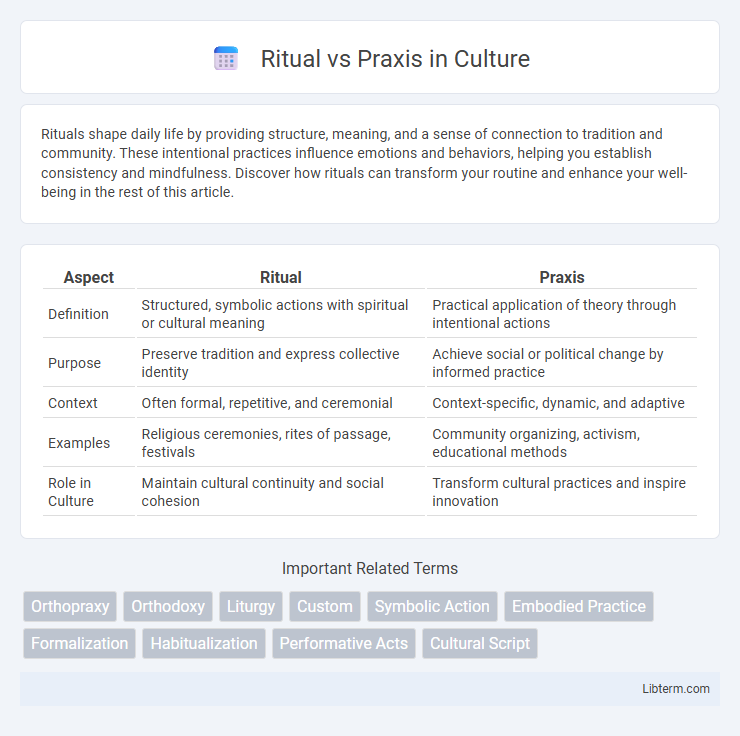Rituals shape daily life by providing structure, meaning, and a sense of connection to tradition and community. These intentional practices influence emotions and behaviors, helping you establish consistency and mindfulness. Discover how rituals can transform your routine and enhance your well-being in the rest of this article.
Table of Comparison
| Aspect | Ritual | Praxis |
|---|---|---|
| Definition | Structured, symbolic actions with spiritual or cultural meaning | Practical application of theory through intentional actions |
| Purpose | Preserve tradition and express collective identity | Achieve social or political change by informed practice |
| Context | Often formal, repetitive, and ceremonial | Context-specific, dynamic, and adaptive |
| Examples | Religious ceremonies, rites of passage, festivals | Community organizing, activism, educational methods |
| Role in Culture | Maintain cultural continuity and social cohesion | Transform cultural practices and inspire innovation |
Understanding Ritual and Praxis
Ritual refers to a set of prescribed actions performed mainly for symbolic or religious purposes, often emphasizing tradition and repeated patterns. Praxis involves the practical application of a theory or belief in real-life action, highlighting conscious, purposeful practice aimed at transformation or change. Understanding ritual emphasizes its role in cultural continuity and symbolism, while praxis focuses on intentional, reflective action to influence social or personal outcomes.
Defining Ritual: Meaning and Purpose
Ritual refers to a set of prescribed actions or ceremonies performed in a specific order, often imbued with symbolic meaning to reinforce cultural or spiritual beliefs. Its purpose is to connect individuals or communities to shared values, tradition, or the sacred, fostering a sense of identity and continuity. Rituals can range from religious rites to social customs, emphasizing collective participation and symbolic expression over practical outcomes.
What is Praxis? Key Concepts
Praxis refers to the process by which theory, lesson, or skill is enacted, practiced, embodied, or realized. Key concepts of praxis include reflective action, where critical thinking informs practical activity, and the integration of theory and practice to effect meaningful change. Praxis emphasizes intentional, conscious engagement in social or political activities, transforming knowledge into transformative practice.
Historical Origins of Ritual and Praxis
Rituals originated in ancient religious and cultural practices, serving as symbolic acts to connect humans with the sacred or supernatural, often codified in traditions passed down through generations. Praxis, emerging from philosophical and educational contexts, refers to the process of applying theory through reflective action, deeply rooted in Aristotelian and Marxist thought emphasizing transformative practice. The historical divergence highlights rituals as fixed, repetitive ceremonies contrasted with praxis as dynamic, conscious engagement in social and political change.
Ritual vs Praxis: Core Differences
Ritual involves formalized, repetitive actions often rooted in tradition or religious practice, emphasizing symbolic meaning and social cohesion. Praxis refers to the process of applying theory through reflective, intentional action aimed at achieving transformative outcomes or practical change. The core difference lies in ritual's focus on symbolic continuity versus praxis's emphasis on dynamic, purposeful activity informed by critical reflection.
The Role of Belief in Ritual and Praxis
The role of belief in ritual and praxis is central, as rituals often require a shared symbolic framework grounded in collective belief systems, enabling participants to find meaning and cohesion within prescribed actions. Praxis, conversely, integrates belief with reflective action, emphasizing purposeful, conscious engagement that transforms both individual and social realities through informed practice. This distinction underscores how belief shapes ritual as predefined acts of faith, while praxis embodies belief realized through dynamic and intentional behavior.
Contexts Where Ritual Dominates
Ritual dominates in religious and cultural contexts where symbolic actions reinforce community identity and shared beliefs, such as in ceremonies, festivals, and rites of passage. These rituals provide structure and meaning, often performed in precise sequences that connect participants to tradition and collective memory. In contrast to praxis, which emphasizes practical action and change, ritual focuses on preserving continuity and expressing values within specific social or spiritual frameworks.
Praxis in Daily Life and Society
Praxis in daily life and society refers to the practical application of beliefs, theories, or skills through conscious, reflective action that drives social change and personal growth. It emphasizes active participation and critical engagement rather than mere ritualistic repetition, influencing education, politics, and community development to address real-world challenges. By embodying values and knowledge in concrete behaviors, praxis fosters transformative experiences that reshape social structures and individual identities.
Intersections: When Ritual Meets Praxis
Ritual and praxis intersect where symbolic actions translate into meaningful practice, shaping both individual and collective behavior. Rituals provide structured frameworks that give praxis cultural and emotional resonance, reinforcing identity and social cohesion. This convergence fosters transformative experiences, blending tradition with intentional action to drive social change.
Implications for Modern Spirituality and Practice
Ritual in modern spirituality serves as a structured, symbolic framework that reinforces communal identity and spiritual discipline, while praxis emphasizes personal experience and transformative action, fostering individual growth and ethical living. The implications for contemporary practice reveal a dynamic interplay where ritual provides continuity and shared meaning, and praxis drives innovation and adaptation to current existential challenges. Integrating both elements can deepen spiritual engagement by balancing tradition's stability with praxis's flexibility and relevance.
Ritual Infographic

 libterm.com
libterm.com